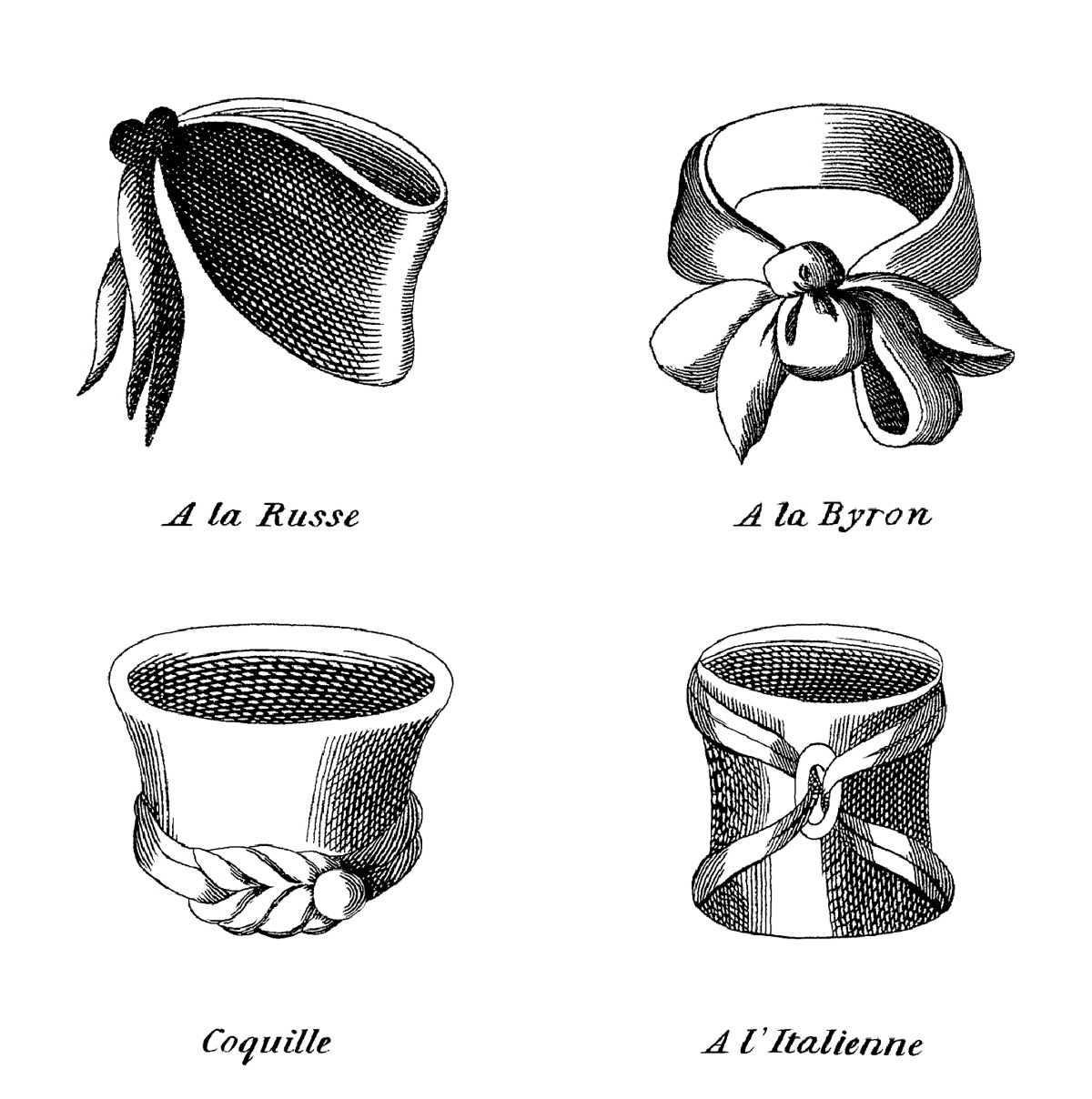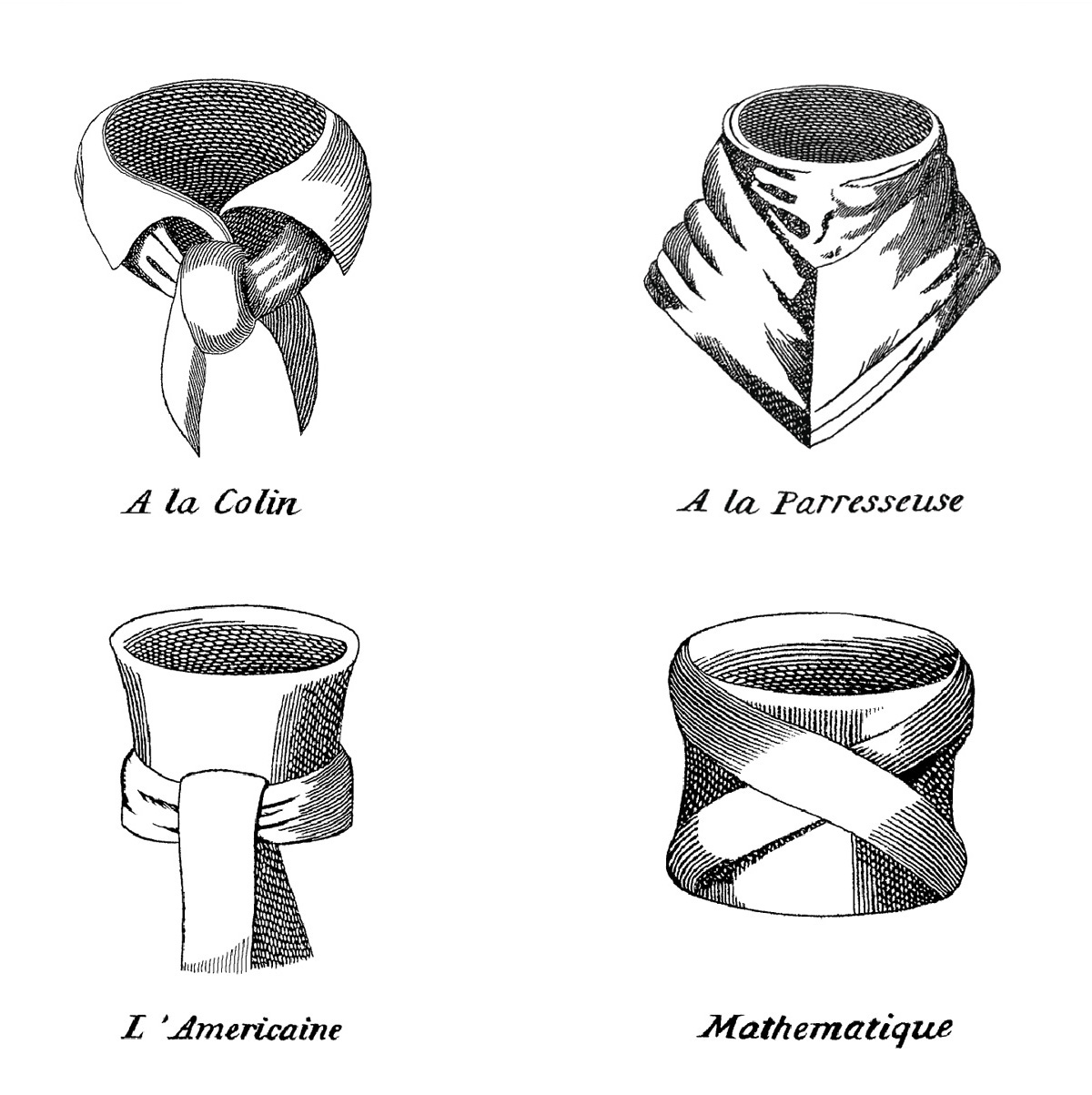Inventory / A Poet of Cloth
Beau Brummell’s knot theory
Brian Dillon
“Inventory” is a column that examines or presents a list, catalogue, or register.
Lord Byron is said to have declared that of the two men he admired most—Beau Brummell and Napoleon Bonaparte—he would rather have been the dandy than the emperor. As a young man, he scrupulously followed Brummell’s sartorial dicta, and was never seen without a white cravat. (Napoleon wore a black neckcloth, a habit condemned by the Beau.) Byron later abandoned his fastidiousness to the extent of having early portraits overpainted with an open-necked shirt, but for a time he embodied Brummell’s philosophy: the maximum of luxury in the service of minimal ostentation. Among the poet’s papers, there survives a document from 1805 that records Byron’s requirements in the way of cloth for the spring of that year: seventy-five yards of Irish linen, for shirts and bedsheets; over four yards of French cambric, for shirt fronts; Russia-towelling, for bath towels; and a quantity of damask linen, to be made into nightshirts. Also: six nightcaps.[1] Curiously, no mention is made of the raw material for his cravats, the articles that would later inspire Thomas Carlyle, in his Sartor Resartus, to satirize the dandy as “inspired with Cloth, a Poet of Cloth.”

The aesthetic embodied in Brummell (1778–1840) is equal parts asceticism and profligacy. The masculine attire he pioneered is notably sober: a simple costume of dark coat and pale trousers, based on the uniform of his former regiment, the Light Dragoons. As his biographer Captain Jesse pronounced, gentlemanliness is an austere calling: a man of quality, for example, ought never to admit to being thirsty or cold. But the dandy’s poise is swaddled in an argosy of rich fabrics; a German prince, visiting London at the turn of the century, noted: “an elegant then requires per week, twenty shirts, twenty-four pocket handkerchiefs, nine or ten pairs of ’summer trousers,’ thirty neck handkerchiefs (unless he wears black ones), a dozen waistcoats, stockings à discretion.” All of this to appear not to have taken much care in one’s appearance at all. In this sense, the dandy’s dress code resembles the mechanism of Brummell’s wit. When he accosted a preening acquaintance with the words, “Do you call this thing a coat?” or announced of a gouty limb, “It’s my favorite leg,” he resisted the flourish of an aphorism or aperçu. Rather, as William Hazlitt had it, Brummell’s jokes exercise prodigious thought to modest ends: “they hover on the very brink of vacancy, and are in their shadowy composition next of kin to nonentities.”[2]
Accordingly, reports of Brummell’s jests and eccentricities often differ in wording and detail. Accounts of his heyday as favorite of the Prince Regent and flippant dictator of London fashions tend, however, to agree on one episode: the moment when his valet Robinson emerged from his master’s dressing room laden with wrinkled cravats and announced, “These are our failures.”The disjecta membra of the Beau’s late-morning toilet had first been subjected to rigorous testing. Jesse describes the process of putting on a cravat: “The collar, which was always fixed to his shirt, was so large that, before being folded down, it completely hid his head and face, and the white neckcloth was at least a foot in height. The first coup d’archet was made with the shirt collar, which he folded down to its proper size; and Brummell then standing before the glass, with his chin poked up to the ceiling, by the gentle and gradual declension of his jaw, creased the cravat to reasonable dimensions, the form of each succeeding crease being perfected with the shirt which he had just discarded.”[3] The spectacle of this self-sculpture drew an envious, admiring audience; they were watching the painful birth of Brummell’s most lasting and mysterious invention: the nineteenth-century necktie.

By the time a number of quasi-comic cravat-tying manuals started to appear, schooling the would-be gentleman in the complex significance of different techniques, Brummell was already in disgrace in France, having fallen from favor with the Prince Regent and gambled away most of his money. His spirit survives, however, in the pages of Neckclothitania (by “one of the cloth”), published in 1818.[4] Here, the author is first exercised by the distressing democratization of modern costume: “It can hardly be imagined how political events should, even in the remotest way, influence or affect the thermometer of fashion, but it is nevertheless perfectly true that both the American and French revolutions have totally changed it.” Where formerly the expense of finery ensured that one could tell a person of haut ton from a pretender, the new simplicity of dress confounds such judgments, and contemporary fashions seem to embody the notion of equality: “a monstrous and unnatural supposition.” Still, there are niceties of attire by which one can spot a gentleman: chief among them, the style of his cravat.
The numerous alternative knots are laid out in a series of illustrations, each showing a disembodied cravat tied tightly around an invisible throat. There is the Mathematical tie, with its distinct three creases; the “pretty and easily formed” American; the rather vulgar Horse Collar. There is the excruciating Oriental knot, “made with a very stiff and rigid cloth, so that there cannot be the least danger of its yielding or bending to the exertions of the head and neck.” So merciless is its stricture, and the head consequently so elevated, that a wearer of the author’s acquaintance, on being introduced to a friend’s diminutive aunt at a soirée, tripped over the unseen lady, falling “headlong into the lap of an old dowager.” Starch is essential to almost all the styles listed, and white the favored color, although alternatives are permitted. The American tie, which “differs little from the Mathematical, except that the collateral indentures do not extend so near to the ear,” is best worn in “ocean green.” The most suitable color for the Osbaldstone is “ethereal azure”; for the Trove d’Amour, “yeux de fille en extase”; for the Mathematical, “la couleur de la cuisse d’une nymphe emue.”[5]

The whole fanciful inventory is aired again in 1828 in H. Le Blanc’s The Art of Tying the Cravat, which details thirty-two styles, provides sixteen careful lessons in tying, and appends “the latest Parisian improvements and amplifications.”[6] The book was issued by Honoré de Balzac’s printers, and the novelist was suspected of having written it himself; it now seems likely that it was the work of his friend Emile-Marc de Saint-Hilaire. The pseudonymous author provides a short history of the cravat: from the “chin cloth” worn by the Romans, through the origin of the word itself in the uniform of Croat soldiers, to the recent history of an article which had become so outlandish that “the neck was placed on a level with the head, which in size it surpassed, and with which it was confounded.” The fashion for starch became so binding, says Le Blanc, that “the head could only be turned by general consent of all the members. ... The tout ensemble was that of an unfinished statue.” He then goes on to list the main styles now in circulation: the cravat De Chasse, En Valise, Coquille, À la Colin, À la Parresseuse, À l’Italien, À la Russe. He pauses to deprecate the Jesuitique, which is a mere starched collar, “a cravat in appearance only.”
Despite this profusion of rules, all far too complex to have impressed the Beau, there is one stipulation of Le Blanc’s that he has inherited directly from Brummell. Once tied, the necktie should never be altered in the hope of improving its appearance; if it is ill-tied, one must start again with a fresh cravat. What the wearer is after is a “curious mean” (as Virginia Woolf wrote of Brummell’s jokes) between skill and pure chance. The tying of a cravat involves the rigorous removal of human agency from the final appearance of the fabric: the knot is intentional, but the folds are entirely fortuitous. As Giorgio Agamben has put it, Brummell, “whom some of the greatest poets of modernity have not disdained to consider their teacher, can, from this point of view, claim as his own discovery the introduction of chance into the artwork so widely practiced in contemporary art.”[7] Beau Brummell is a direct precursor of the dandy Marcel Duchamp. The dandy’s intention is in fact to make the garment-like the artwork-evanesce into pure gesture, to institute something like the “threadbare look” described by Jules Barbey d’Aurevilly in his essay on Brummell and dandyism. In a brief craze, says d’Aurevilly, dandies took to rubbing their clothes with broken glass, till they took on the appearance of lace, became “a mist of cloth,” scarcely existed as clothes.[8] Similarly, at its logical extreme, a well-tied cravat is a palpable immateriality, like a distant nebula or a puff of ectoplasm.

At the end, Brummell himself communed with the ghosts of his former finery. Penniless and in the final, maddening, stages of tertiary syphilis, he imagined that he was entertaining friends from his former life—but they were mere shadows. When the money finally ran out, he acknowledged the seriousness of his predicament by resorting to that hateful accessory, a black cravat. In her account of Brummell’s last days, Woolf writes: “Now that the pressure was removed, the odds and ends, so trifling separately, so brilliant in combination, which had made up the being of the Beau, fell asunder and revealed what lay beneath.” The perfect cravat, says the author of Neckclothitania (well aware that the myriad knots he describes are only so many ways to dress a phantom), is so rigid that it does not need to touch the neck to stay in place. The body of the dandy may as well not be there.
- Ian Kelly, Beau Brummell: The Ultimate Dandy (London: Hodder and Stoughton, 2005), p. 166.
- William Hazlitt, “Brummelliana,” in Selected Writings (New York: Penguin, 1970), p. 431.
- Captain Jesse, The Life of Beau Brummell (London: Navarre Society, 1927), p. 46.
- Neckclothitania or Tietania, Being an Essay on Starchers, by One of the Cloth (London: J. J. Stockdale, 1818).
- These two phrases translate as “the eyes of a girl in ecstasy” and “the color of the trembling thigh of a nymph,” respectively. The author of Neckclothitania resorts to French here, presumably in part because of the suggestive language.
- H. Le Blanc, The Art of Tying the Cravat (London: Effingham Wilson, 1828).
- Giorgio Agamben, Stanzas: Word and Phantasm in Western Culture, trans. Ronald L. Martinez (Minneapolis: University of Minnesota Press, 1993), p. 53.
- Jules Barbey d’Aurevilly, “On Dandyism and George Brummell,” trans. George Walden, in Who’s a Dandy? (London: Gibson Square, 2002), p. 80.
Brian Dillon is UK editor of Cabinet, and writes regularly for Frieze, The Financial Times, and New Statesman. He is author of a memoir, In the Dark Room (Penguin, 2005), and is working on a cultural history of hypochondria. He lives in Canterbury.